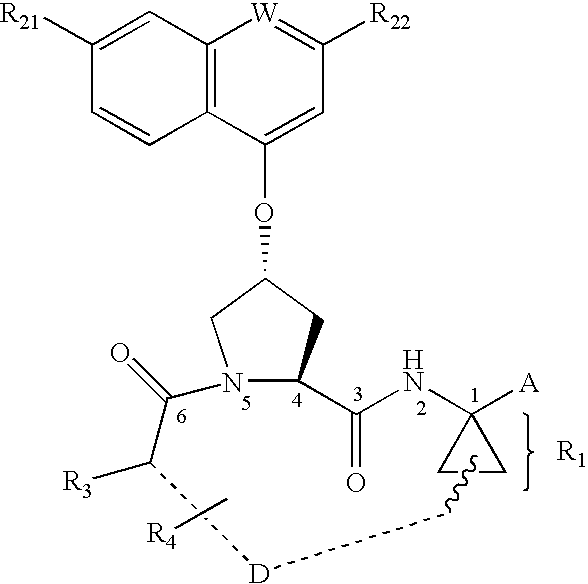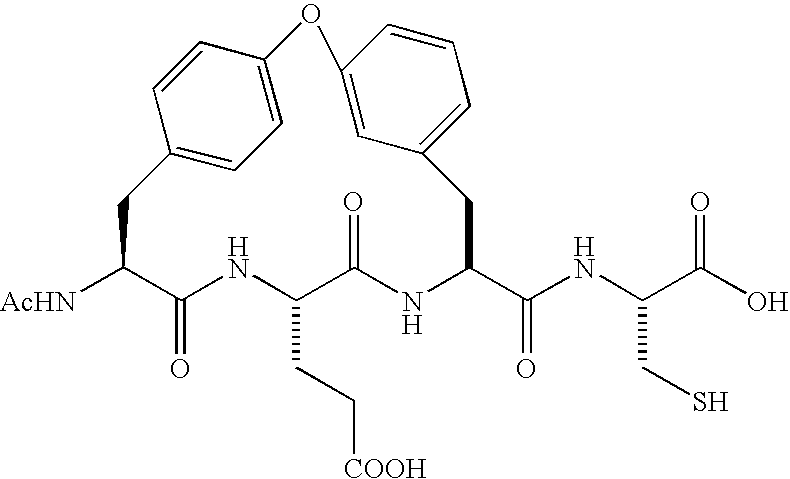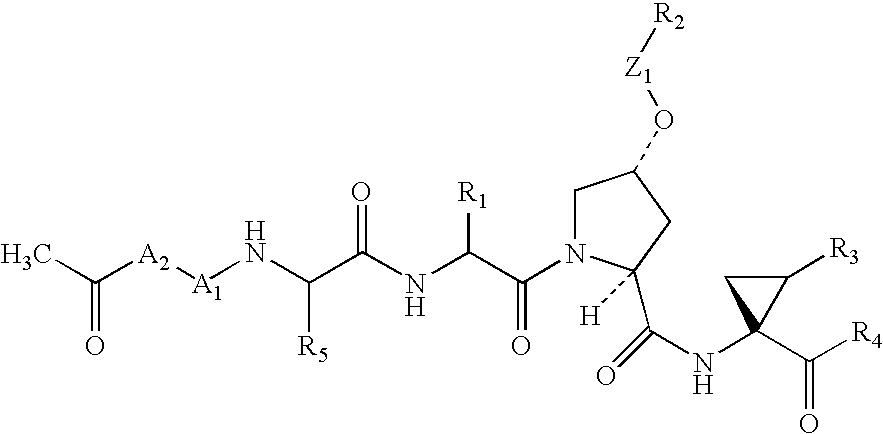Substituted prolines as inhibitors of hepatitis C virus NS3 serine protease
a protease inhibitor and hcv technology, applied in the direction of dipeptides, peptides, drug compositions, etc., can solve the problems of low sustained response rate of therapies, frequent side effects, and poor treatment effect of patients with hcv infection
- Summary
- Abstract
- Description
- Claims
- Application Information
AI Technical Summary
Benefits of technology
Problems solved by technology
Method used
Image
Examples
example 101
Synthesis of Example 101
Step 1
[0286]
To a stirred solution of the proline derivative 1.01 (3.66 mmol, prepared as described above) in dichloromethane (20 mL) and DMF (15 mL) at 0° C. was added L-boc-tert-leucine (930 mg, 4.03 mmol), DIPEA (2.02 mL, 10.98 mmol) and HATU (1.8 g, 4.76 mmol). After 15 minutes at that temperature, the reaction flask was stored in the freezer (−20° C.), overnight (16 hr). The reaction mixture was diluted with dichloromethane (80 mL) and washed with saturated sodium bicarbonate solution (80 mL), 10% aq. citric acid solution (80 mL), brine (80 mL), dried (Na2SO4), filtered and concentrated. The crude material was purified by silica chromatography using 25 / 75 to 50 / 50 EtOAc / hexanes to provide 1.77 g of the required material, 101 a. LC-MS: 518.1 (M+H)+.
Step 2
[0287]
To a solution of the methyl ester 101a (1.21 g, 2.34 mmol) in THF (10 mL) and MeOH (5 mL) was added aq. 1M LiOH solution (5 mL). The reaction mixture was stirred at RT for 4 h. It was then concentrat...
example 102
Synthesis of Example 102
Step 1
[0292]
The required compound 102 was prepared from 101e and intermediate 63.01 using procedure described above for Example 101, Step 6. LC-MS of 102: 829.2 (M+H)+.
example 103
Synthesis of Example 103
Step 1
[0293]
The required compound 103 was prepared from 101e and intermediate 64.01 using procedure described above for Example 101, Step 6. LC-MS of 103: 804.2 (M+H)+.
[0294]In procedures similar to those described above, the other compounds in Table 2 were prepared. Additionally, the compounds in Table 1 can also be prepared similarly.
[0295]The present invention relates to novel HCV protease inhibitors. This utility can be manifested in their ability to inhibit the HCV NS3 / NS4a serine protease. A general procedure for such demonstration is illustrated by the following in vitro assay.
Assay for HCV Protease Inhibitory Activity:
[0296]Spectrophotometric Assay: Spectrophotometric assay for the HCV serine protease can be performed on the inventive compounds by following the procedure described by R. Zhang et al, Analytical Biochemistry, 270 (1999) 268-275, the disclosure of which is incorporated herein by reference. The assay based on the proteolysis of chromogeni...
PUM
| Property | Measurement | Unit |
|---|---|---|
| temperature | aaaaa | aaaaa |
| temperature | aaaaa | aaaaa |
| temperature | aaaaa | aaaaa |
Abstract
Description
Claims
Application Information
 Login to view more
Login to view more - R&D Engineer
- R&D Manager
- IP Professional
- Industry Leading Data Capabilities
- Powerful AI technology
- Patent DNA Extraction
Browse by: Latest US Patents, China's latest patents, Technical Efficacy Thesaurus, Application Domain, Technology Topic.
© 2024 PatSnap. All rights reserved.Legal|Privacy policy|Modern Slavery Act Transparency Statement|Sitemap



